How to Build a Successful B2B Content Marketing Plan in 2024
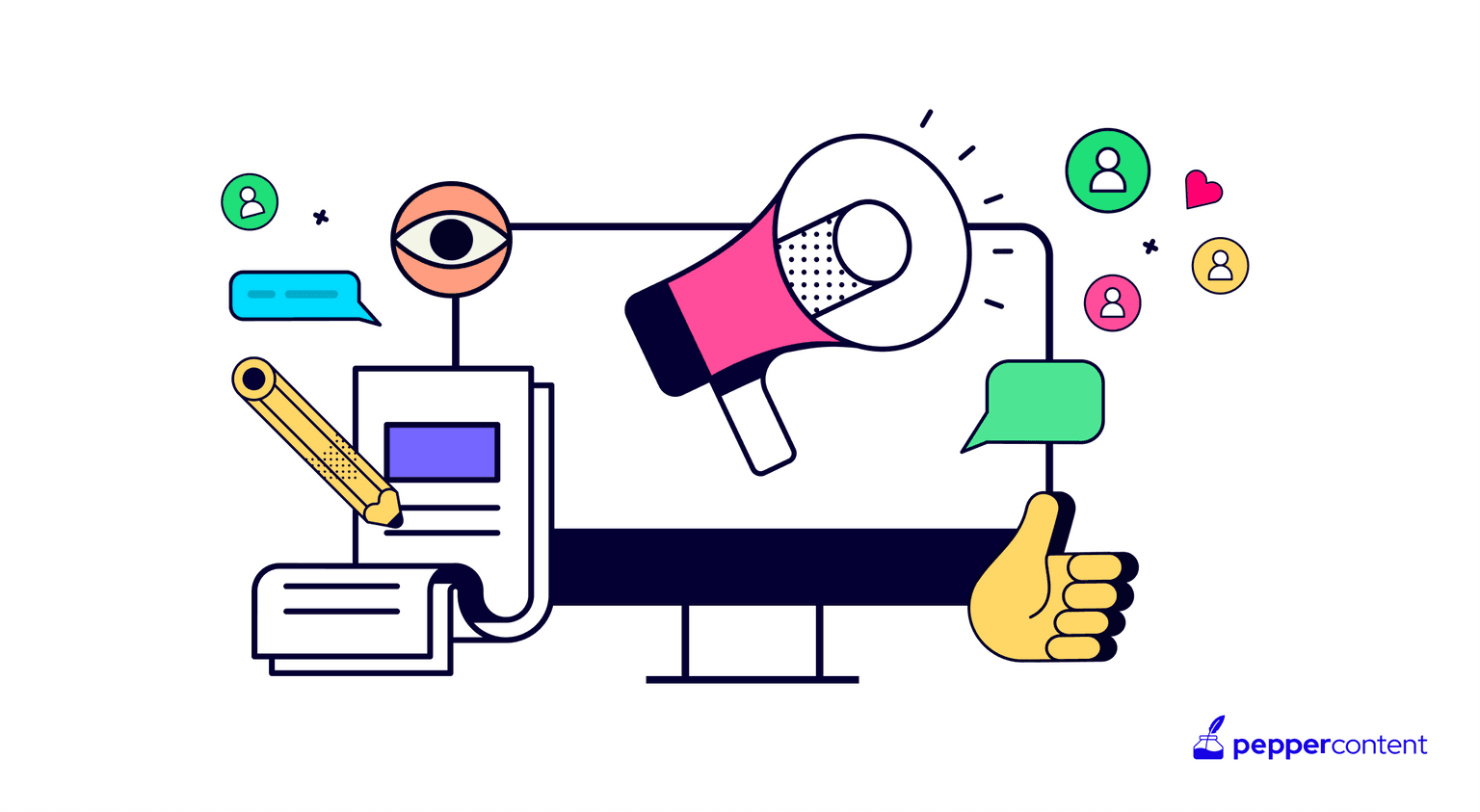
Seth Godin, author, marketing strategist, and creator of the famous TED Conferences, made a simple yet profound statement in 2008 that could define the future of marketing. He said, “Content marketing is the only marketing left.”
The Content Marketing Institute (CMI) defines content marketing as “a strategic marketing approach focused on creating and distributing valuable, relevant, and consistent content to attract and retain a clearly defined audience — and, ultimately, to drive profitable customer action.“
B2B buyers are becoming more digital-savvy, preferring to conduct research independently before engaging with sales representatives. Traditional channels like print media and direct mail are becoming less effective due to the oversaturation of marketing messages. B2B buyers are more likely to engage with content that provides value and is easily accessible online. Moreover, Modern B2B buyers expect personalized content tailored to their specific needs and challenges. Traditional methods often lack the ability to deliver this level of personalization.
Studies indicate that B2B content marketing generates 3x more leads than all traditional marketing forms while saving up to 62% of overall expenditure in the process.
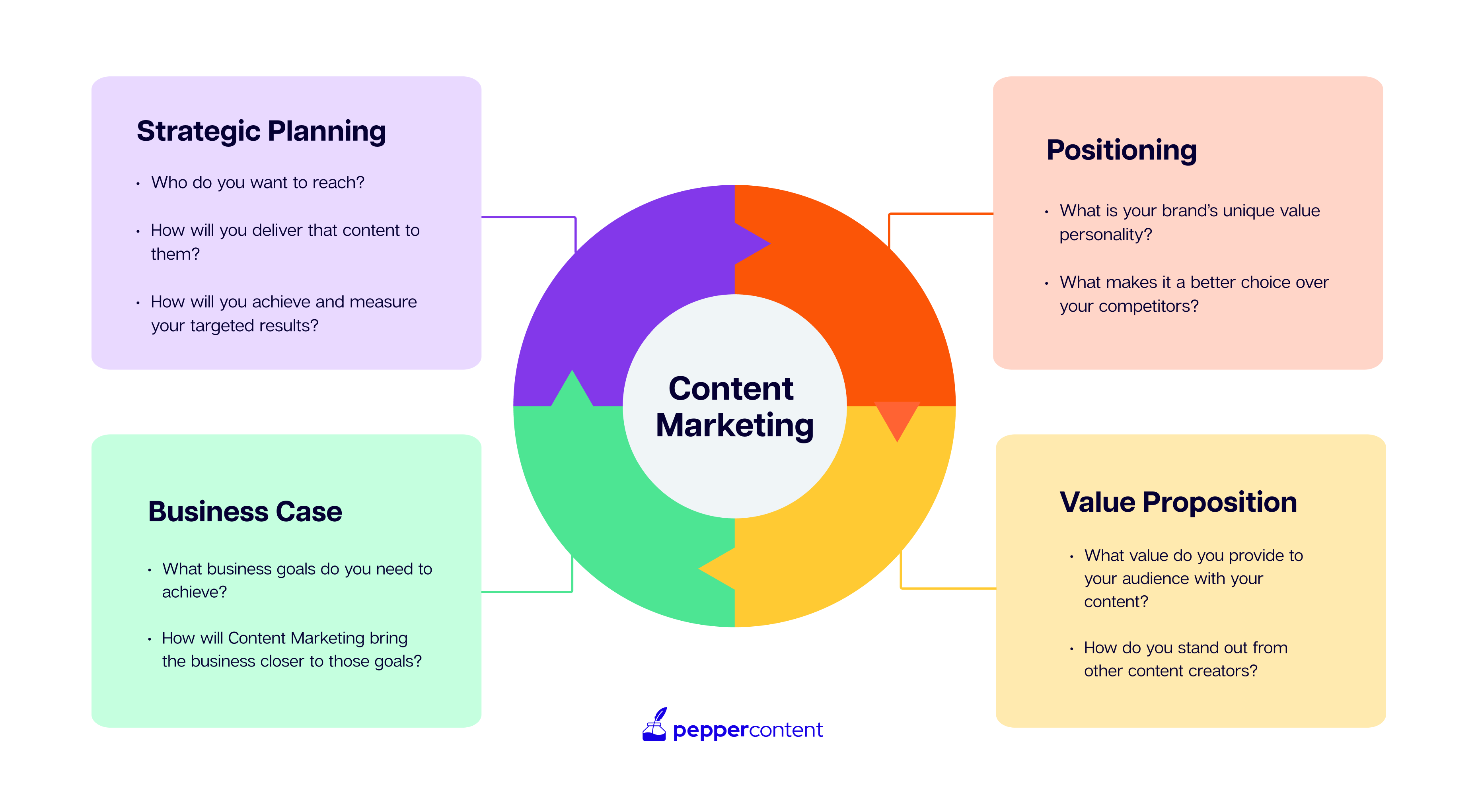
This suggests that a B2B content marketing strategy functions as the foundation or roadmap for your company. It steers you from one objective to the next, ensuring you stay focused on your goals. Without it, you risk facing confusion and straying from the path.
The Evolving B2B Landscape in 2024
Dynamic shifts in market behavior and preferences mark the B2B content marketing landscape in 2024. Businesses are increasingly recognizing the importance of building meaningful relationships with their audience through valuable content. The traditional linear buyer’s journey has given way to a more complex, non-linear path influenced by various touchpoints and channels.
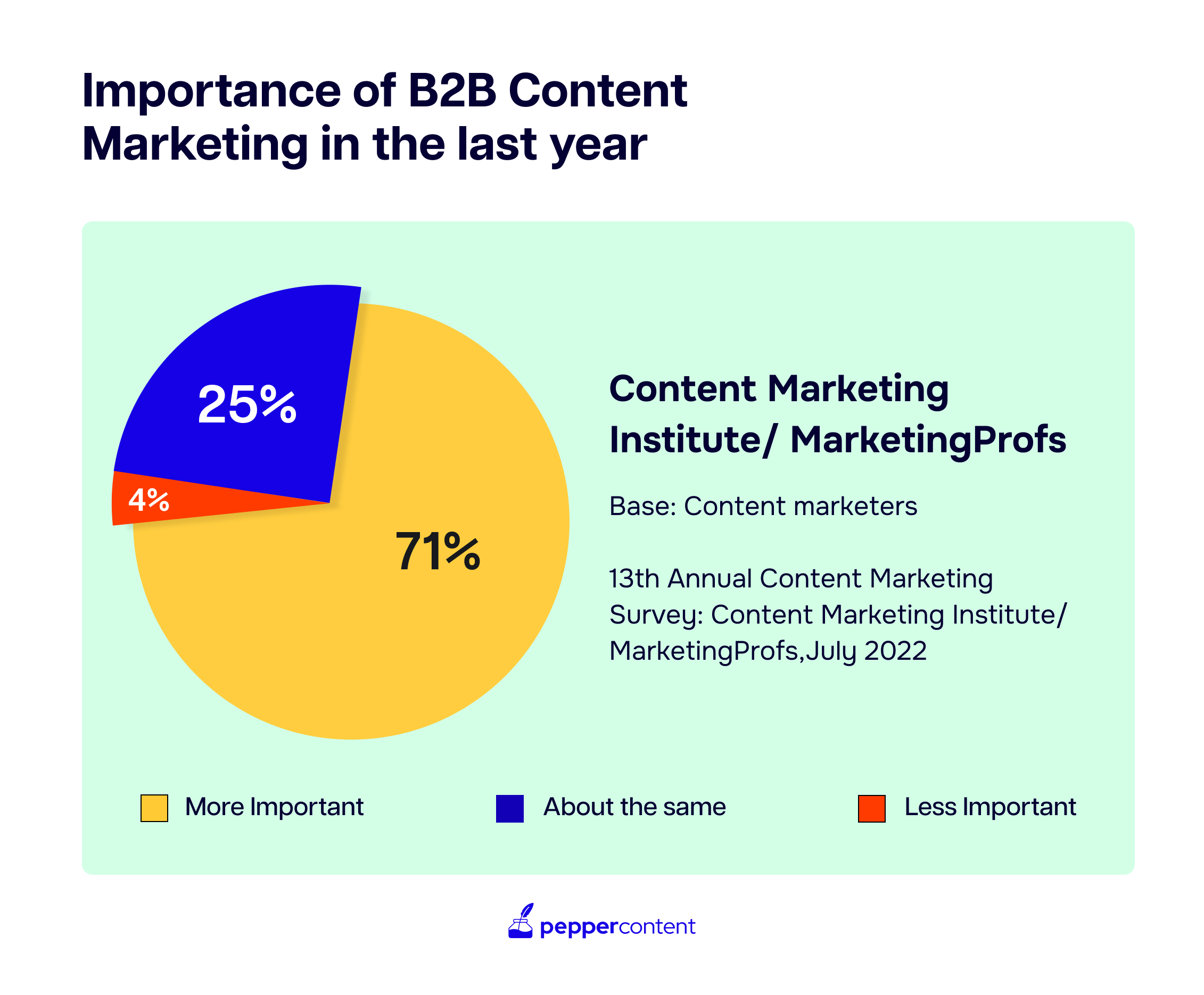
Customers now demand more personalized, relevant content tailored to their needs and challenges. As a result, successful B2B content marketing strategies focus on creating a seamless and engaging experience throughout the buyer’s journey, from awareness to conversion. The rise of e-commerce and the globalization of the economy have made the B2B market increasingly competitive, requiring companies to look for innovative ways to differentiate themselves.
Integrating advanced technologies such as AI and automation is reshaping how B2B content is created, distributed, and consumed.
For example, Businesses leverage AI algorithms to analyze customer behavior, predict preferences, and automate the delivery of tailored content. Chatbots powered by AI also contribute to improved customer interactions and engagement. Marketing automation platforms such as HubSpot and MailChimp enable businesses to deliver the right content to the right audience at the right time, contributing to higher conversion rates.
Similarly, the B2B content marketing landscape is significantly influenced by evolving data privacy laws and algorithmic changes. B2B marketers rely on granular data at all marketing funnel stages to drive more awareness, engagement, and customer advocacy. However, data privacy laws such as the General Data Protection Regulation (GDPR) Act and the California Consumer Privacy Act (CCPA) have made collecting and using customer data harder. B2B marketers must prioritize transparency and consent, ensuring their content strategies align with these regulations.
Setting the Right Objectives
2024 is expected to bring in many challenges in the B2B space. B2B content marketing will, therefore, play a very significant role in helping companies identify, acquire, and retain customers.
Companies will have to go beyond the usual KPIs of leads and customer retention rates, which will require a comprehensive approach that involves strategic alignment, buyer journey mapping, and a data-driven, ROI-focused mindset.
A 2022 study by the Content Marketing Institute (CMI) indicated that the number one challenge for B2B organizations is difficulty creating content that appeals to the different stages of the buyer’s journey. And only a mere 2% of marketers say they do not face any challenges.
Hence, understanding the stages of your buyer’s journey is fundamental to effective content marketing. Each step demands a tailored approach from awareness to consideration, decision, and post-purchase. Content should be crafted to address specific pain points and provide valuable information at every step, nurturing leads toward conversion.
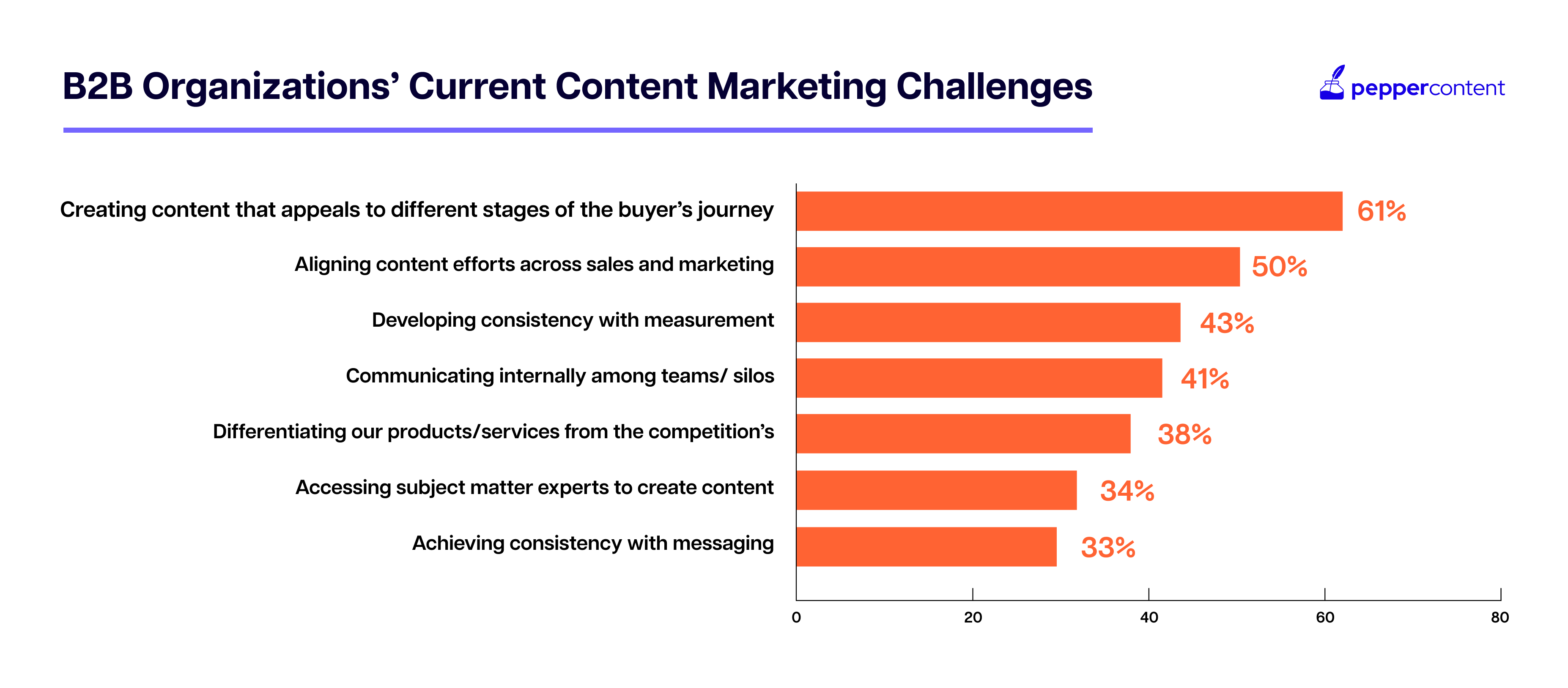
To maximize the impact of content marketing, objectives must align with broader business goals. Whether it’s increasing brand awareness, driving sales, or establishing thought leadership, clarity in alignment ensures that every content piece serves a strategic purpose in advancing the overall business agenda. By tracking metrics like customer acquisition costs, conversion rates, and revenue generated, businesses can assess the actual value of their content strategies and optimize them for maximum ROI.
The Role of Audience Segmentation and Personalization
Successful B2B content marketing hinges on accurately identifying and understanding your target audience. Beyond demographics, consider factors like industry challenges, pain points, and decision-making processes. Personalization is applied to tailor content to specific audience segments, making it more relevant and engaging.
Studies show that nearly 63% of companies are investing in improving their user experience by adding new personalization techniques. However, 40% of companies admit personalization to be a major challenge. Below are some of the key tactics that will help you better personalize your B2B marketing efforts:
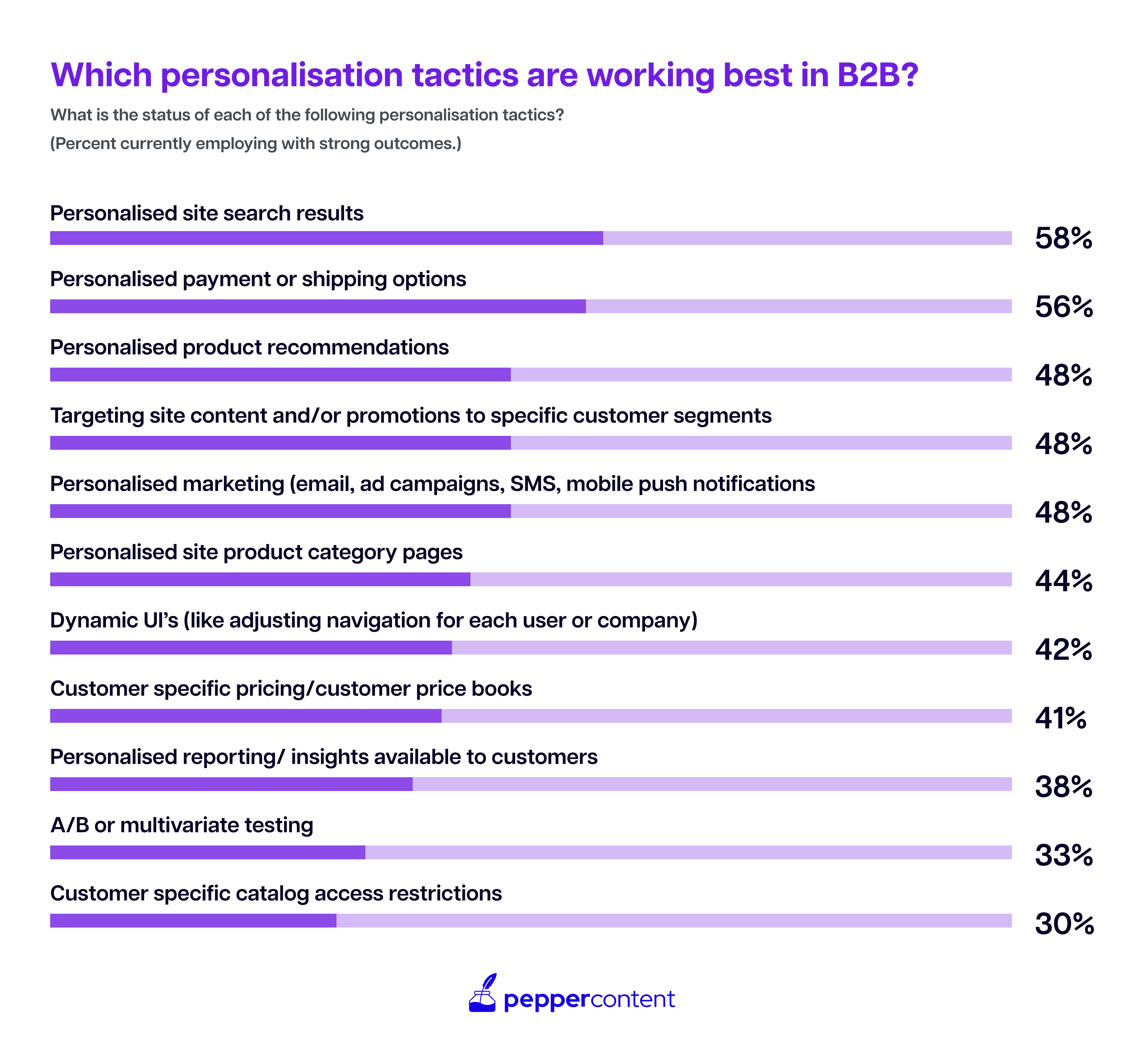
Adobe’s blog on B2B commerce personalization tactics highlights several data-backed techniques that can help you better engage with your audience and drive conversion:
-
Account-Based Personalization: Tailoring content to specific accounts or companies based on their needs and preferences.
-
Predictive Personalization: Utilizing machine learning algorithms to predict customer preferences and provide personalized content recommendations.
-
Dynamic Content: Creating dynamic, adaptive content that changes based on user behavior and preferences.
-
Real-Time Personalization: Adapting content in real-time based on user interactions and data insights.
On the other hand, data analytics plays an important role in creating highly targeted content. Businesses can identify patterns and trends that inform content creation by analyzing customer behavior, preferences, and interactions. Advanced analytics tools such as Google Analytics and SEMrush can provide insights into which content types, formats, and distribution channels resonate most with specific audience segments.
Deep-Dive Into Content Strategy for 2024
It’s important to remember that there’s no “one-size-fits-all” content marketing strategy for all B2B companies. Every business has its own story, so your marketing plan should be designed to suit your content needs. It’s a good idea to begin by setting clear goals. Knowing where you want to end up in the long run is also essential.
In 2024, B2B marketers need to focus on creating high-quality content that is relevant, informative, and engaging content. The key elements of your B2B content marketing strategy should, therefore, include the following:
-
Personalization. Use data and analytics to understand your audience better and create content that is tailored to their specific needs and interests.
-
Interactive content. B2B buyers are increasingly drawn to interactive content like quizzes, polls, calculators, and infographics. The Content Marketing Institute (CMI) found that 55% of marketers use interactive content in their marketing campaigns. Use this type of content to capture attention, educate your audience, and generate leads.
-
Strong video content. Video is a powerful way to tell stories and engage viewers. Create educational videos, product demos, customer testimonials, and other types of video content to reach and engage your target audience.
-
Powerful social media presence. Use social media to distribute your content, connect with your audience, and build relationships.
-
Use AI and automation. AI and automation tools can help you to create and distribute content more efficiently and effectively.
-
Focus on thought leadership. Create content that establishes your company as an expert in your industry and provides valuable insights and solutions to your target audience. Thought leadership content — including case studies and whitepapers — often includes detailed pieces, including original research. A prime example is marketing expert Neil Patel, who leverages videos, blogs, and social media to share insights, educate, and express opinions on various marketing topics.
-
Focus on evergreen content. This will reduce the amount of time you spend creating new content and focus on promoting and republishing your existing content. BuzzSumo states that evergreen content is 3x more likely to be shared than non-evergreen content. A DemandGen report cited by HubSpot confirms that evergreen content generates 9x more leads than non-evergreen content.
-
Measure and analyze your results. It’s important to track your content marketing results to see what’s working and what’s not. This will help refine your strategy and improve your results over time.
SEO in 2024: What’s Changed?
SEO has evolved significantly, driven by technological advancements, user behavior changes, and search engine algorithm updates. Several key factors contribute to the transformation of SEO practices, including:
Core Web Vitals and Page Experience
Introduced by Google, Core Web Vitals have become a crucial element in SEO. These metrics assess the user experience on a webpage, including factors like page load time, interactivity, and visual stability. Search engines prioritize pages that offer a positive user experience, and sites failing to meet these criteria may experience a decline in rankings.
Semantic Search and Topic Clusters
Semantic search, powered by natural language processing (NLP) and machine learning (ML), has refined search engines’ understanding of user queries. Instead of focusing solely on keywords, search engines now interpret the context and intent behind the search. This has led to the rise of topic clusters — a content strategy where a pillar page serves as the central topic hub, surrounded by related subtopics. This approach enhances the relevance and authority of content, aligning with semantic search principles.
GA4 (Google Analytics 4)
Google Analytics 4 has become the standard for web analytics. It offers enhanced tracking capabilities, better integration with Google’s advertising platform, and a more comprehensive understanding of user interactions across various platforms and devices. Marketers and SEO professionals leverage GA4 to gather insights into user behavior, refine content strategies, and make data-driven decisions.
Google SGE (Search Guided by Experts)
Google’s Search Guided by Experts is an approach that integrates human expertise with machine learning algorithms. It involves human evaluators assessing the relevance and quality of search results and providing valuable feedback to enhance the search algorithm. This hybrid model aims to improve result accuracy and user satisfaction by combining human intelligence and AI capabilities.
AI and Machine Learning in SEO Strategy
AI and machine learning play a central role in shaping SEO strategies. Search engines use machine learning algorithms to better understand user intent, deliver more accurate search results, and detect patterns in content quality. SEO professionals leverage AI tools for keyword analysis, content creation, and predictive analytics to stay ahead in the competitive digital landscape.
Distribution Channels: Picking What Works
You have created high-quality content, so you need to distribute it to your target audience. There are many different ways to do this, including your website (the hub of your content marketing strategy), email marketing to current and potential customers, social media (LinkedIn, Twitter, and Facebook, and paid advertising (Google AdWords and Facebook Ads). Creating a distribution calendar is important to plan the distribution.
Once you have distributed your content, you need to monitor its performance to see what’s working and what’s not. Use tracking metrics like website traffic, social media engagement, and email open rates. You can use various tools to monitor your content performance, such as Google Analytics, Hootsuite, and BuzzSumo.
The distribution and monitoring of your B2B content marketing will give you a lot of data — on your customers, competitors, content performance, and other metrics. You need to analyze these data to understand what’s working and what’s not. Analyze metrics like click-through rate, bounce rate, and conversion rate. Use the insights from your analytics to improve your content marketing strategy over time — identify top-performing content, analyze audience engagement, and experiment with new content
formats and topics.
Content Gap and Refresh Strategy
Understanding and addressing content gaps is crucial for maintaining a competitive edge and achieving better Search Engine Results Page (SERP) rankings. A well-defined content gap and refresh strategy involves creating new content and optimizing and updating existing content to meet evolving user needs.
Irrespective of your niche, integrating evergreen content ideas into your approach can be a powerful tool to enhance blog traffic and increase user engagement. But what is it? Evergreen content is timeless, relevant, and valuable content that remains popular and useful over a long time. It is often high-quality, in-depth, and informative and is designed to answer common questions and solve user problems.
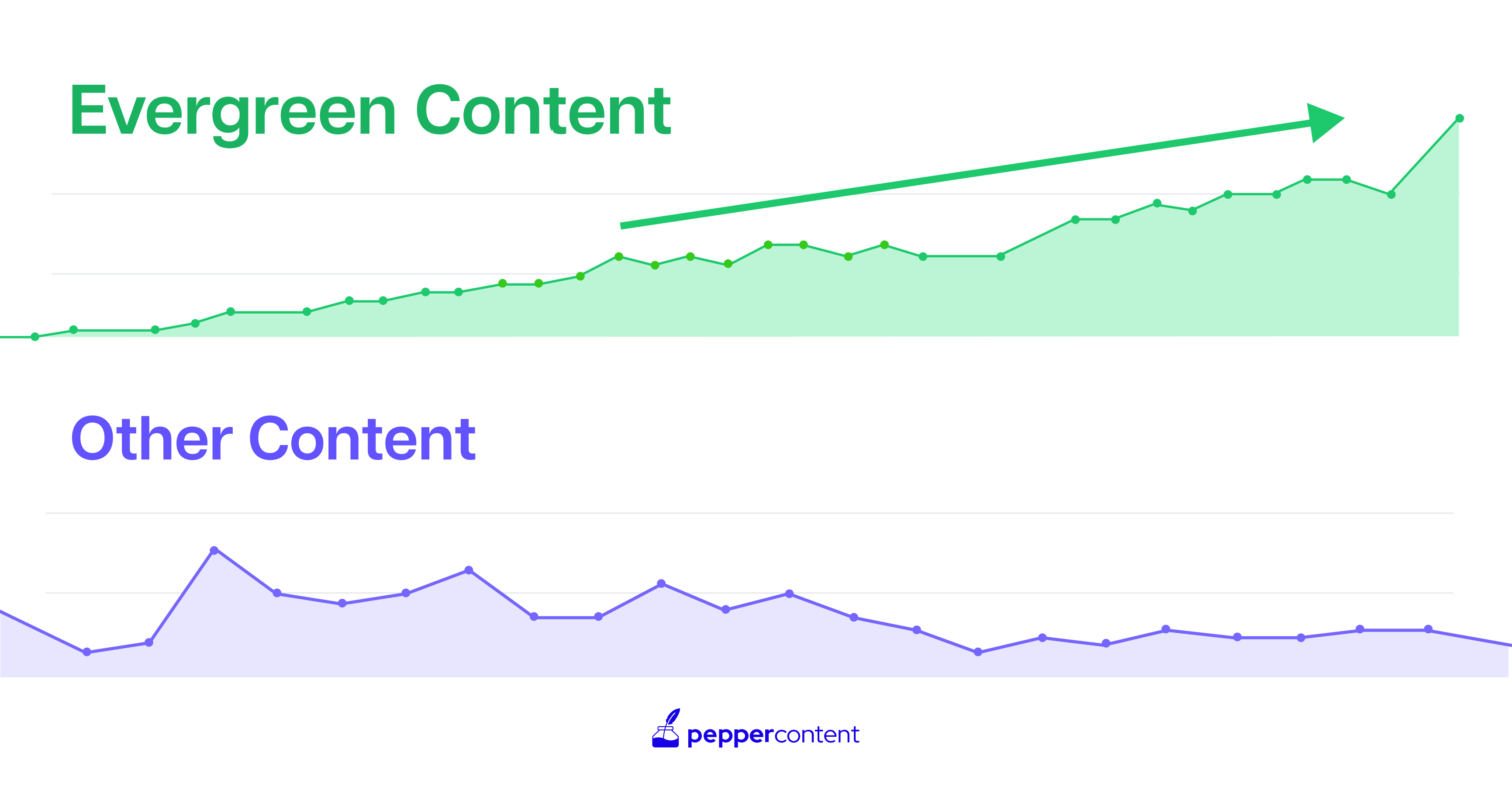
One great example of evergreen content is Wikipedia, which invites contributions from individuals worldwide. This unique approach enables users to add, verify, and update information regularly, making content relevant for extended periods. This dynamic quality transforms the entire platform into a valuable repository of evergreen content, making it an invaluable resource for those interested in historical narratives.
How to Identify and Fill Content Gaps for Better SERP Rankings
By combining evergreen content creation with a proactive strategy to identify and fill content gaps, businesses can enhance their online presence, provide continuous value to their audience, and improve their SERP rankings over time.
Here are some of the steps you can take to identify and fill content gaps:
-
Keyword Research: Conduct thorough keyword research to identify gaps in your existing content. Use tools like Google Keyword Planner, SEMrush, or Ahrefs to discover relevant keywords your target audience is searching for but are not well-covered in your current content.
-
Competitor Analysis: Analyze competitors’ content to identify topics and areas where they have a stronger presence. Look for gaps in their coverage and opportunities where you can provide more valuable or in-depth information.
-
User Intent Analysis: Understand the intent behind user queries. This involves examining the information users seek when entering specific search terms. Create content that aligns with user intent, providing the most relevant and helpful answers.
-
Content Audit: Regularly audit your existing content to identify pieces that are outdated, underperforming, or could benefit from expansion. This audit helps pinpoint content gaps and opportunities for improvement.
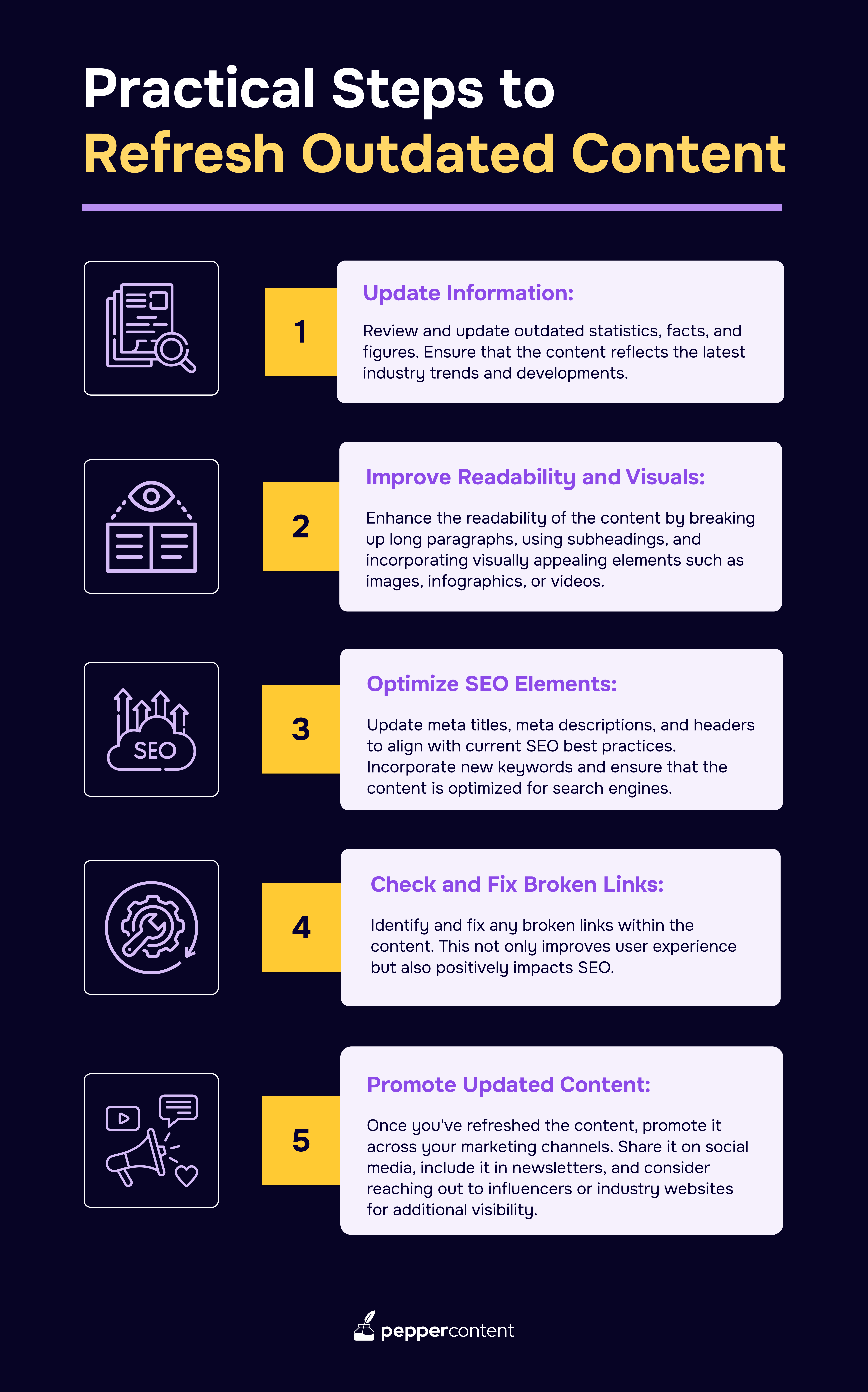
Case Study: HubSpot’s Content Marketing Success
HubSpot is a leading provider of inbound marketing, sales, and customer service software. The company has been widely recognized for its successful content marketing efforts, which have played a significant role in establishing HubSpot as an authority in the digital marketing space.
HubSpot focused on creating in-depth, educational content that addressed the pain points and challenges faced by its target audience. This content ranged from blog posts and ebooks to webinars and online courses.
One brilliant example is their webinar titled “The Science of Email Marketing.” This free, hour-long webinar imparts valuable insights and actionable tips for crafting successful email marketing campaigns. Hosted by HubSpot’s expert marketing team, it covers crucial topics like email list segmentation, best practices in email design, and implementing email automation.
The results garnered from HubSpot’s webinar are nothing short of impressive. Within a year, the HubSpot webinar generated over 20,000 leads and $250,000 in sales, boasting a conversion rate of 12%. Additionally, it has been viewed more than 75,000 times, earning a satisfaction rating of 94% from attendees.
HubSpot’s success with webinars can be attributed to several key factors:
-
They meticulously identified their target audience. Their webinar was designed to offer practical insights and strategies for leveraging LinkedIn Ads to generate leads.
-
What sets HubSpot apart is its engaging and knowledgeable marketing team, capable of delivering insights and tips that are both accessible and easy to implement.
-
They executed a comprehensive marketing strategy that included blog posts, social media ads, and email campaigns to ensure maximum reach and drive registrations.
HubSpot Academy, an online learning platform, offered free certification courses on inbound marketing, content marketing, and other relevant topics. This not only provided value to users but also positioned HubSpot as a trusted source of industry knowledge.
By adopting an audience-centric approach, embracing diverse content formats, maintaining consistency, and investing in education, businesses can emulate HubSpot’s success in content marketing.HubSpot’s journey serves as a valuable case study for companies looking to establish themselves as thought leaders and build lasting relationships with their B2B audience through content.
Conclusion
B2B content marketing is a powerful way to attract and retain customers. By creating valuable, relevant, and consistent content, businesses can build relationships with potential customers and drive profitable customer action. To create a successful B2B content marketing plan, companies need to understand their target audience, choose the right channels to distribute their content, and measure the results of their content marketing efforts.
In a landscape where content is not just king but the cornerstone of digital success, Pepper Content stands as your trusted partner, ready to elevate your brand’s narrative and drive meaningful engagement.
As you navigate the challenges and opportunities of B2B content marketing in 2024, let Pepper Content be the catalyst for your success, delivering tailored content and writing services that resonate with your audience and propel your business toward new heights.
Reach out to us today to create content that will drive your business value!
Latest Blogs
Explore how Google’s 2025 AI search updates triggered ranking chaos. Learn actionable strategies to adapt your SEO for AI Overviews, zero-click searches, and SERP volatility. Stay ahead now.
Learn how to rank on AI search engines like ChatGPT, Perplexity, and Gemini by optimizing your content for authority, structure, and relevance. Stay ahead in AI-driven search with this strategic guide.
Explore the best healthcare SEO services for your medical practice. Improve online visibility and effectively reach more patients in need of your services.
Get your hands on the latest news!
Similar Posts

Content Strategy
5 mins read
Choosing The Best Healthcare Marketing Agency For Effective Content Solutions

Content Marketing
4 mins read
Top 10 Agencies B2B SaaS Content Marketing for B2B Success

B2C Marketing
5 mins read